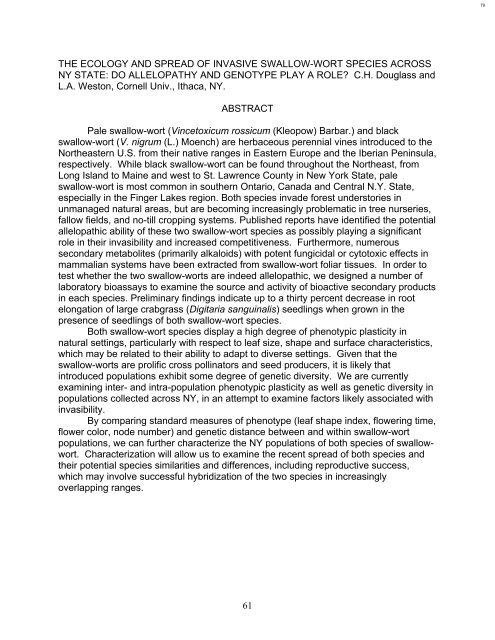Proceedings of the Sixty-first Annual Meeting of the Northeastern ...
Proceedings of the Sixty-first Annual Meeting of the Northeastern ...
Proceedings of the Sixty-first Annual Meeting of the Northeastern ...
You also want an ePaper? Increase the reach of your titles
YUMPU automatically turns print PDFs into web optimized ePapers that Google loves.
79<br />
THE ECOLOGY AND SPREAD OF INVASIVE SWALLOW-WORT SPECIES ACROSS<br />
NY STATE: DO ALLELOPATHY AND GENOTYPE PLAY A ROLE? C.H. Douglass and<br />
L.A. Weston, Cornell Univ., Ithaca, NY.<br />
ABSTRACT<br />
Pale swallow-wort (Vincetoxicum rossicum (Kleopow) Barbar.) and black<br />
swallow-wort (V. nigrum (L.) Moench) are herbaceous perennial vines introduced to <strong>the</strong><br />
Nor<strong>the</strong>astern U.S. from <strong>the</strong>ir native ranges in Eastern Europe and <strong>the</strong> Iberian Peninsula,<br />
respectively. While black swallow-wort can be found throughout <strong>the</strong> Nor<strong>the</strong>ast, from<br />
Long Island to Maine and west to St. Lawrence County in New York State, pale<br />
swallow-wort is most common in sou<strong>the</strong>rn Ontario, Canada and Central N.Y. State,<br />
especially in <strong>the</strong> Finger Lakes region. Both species invade forest understories in<br />
unmanaged natural areas, but are becoming increasingly problematic in tree nurseries,<br />
fallow fields, and no-till cropping systems. Published reports have identified <strong>the</strong> potential<br />
allelopathic ability <strong>of</strong> <strong>the</strong>se two swallow-wort species as possibly playing a significant<br />
role in <strong>the</strong>ir invasibility and increased competitiveness. Fur<strong>the</strong>rmore, numerous<br />
secondary metabolites (primarily alkaloids) with potent fungicidal or cytotoxic effects in<br />
mammalian systems have been extracted from swallow-wort foliar tissues. In order to<br />
test whe<strong>the</strong>r <strong>the</strong> two swallow-worts are indeed allelopathic, we designed a number <strong>of</strong><br />
laboratory bioassays to examine <strong>the</strong> source and activity <strong>of</strong> bioactive secondary products<br />
in each species. Preliminary findings indicate up to a thirty percent decrease in root<br />
elongation <strong>of</strong> large crabgrass (Digitaria sanguinalis) seedlings when grown in <strong>the</strong><br />
presence <strong>of</strong> seedlings <strong>of</strong> both swallow-wort species.<br />
Both swallow-wort species display a high degree <strong>of</strong> phenotypic plasticity in<br />
natural settings, particularly with respect to leaf size, shape and surface characteristics,<br />
which may be related to <strong>the</strong>ir ability to adapt to diverse settings. Given that <strong>the</strong><br />
swallow-worts are prolific cross pollinators and seed producers, it is likely that<br />
introduced populations exhibit some degree <strong>of</strong> genetic diversity. We are currently<br />
examining inter- and intra-population phenotypic plasticity as well as genetic diversity in<br />
populations collected across NY, in an attempt to examine factors likely associated with<br />
invasibility.<br />
By comparing standard measures <strong>of</strong> phenotype (leaf shape index, flowering time,<br />
flower color, node number) and genetic distance between and within swallow-wort<br />
populations, we can fur<strong>the</strong>r characterize <strong>the</strong> NY populations <strong>of</strong> both species <strong>of</strong> swallowwort.<br />
Characterization will allow us to examine <strong>the</strong> recent spread <strong>of</strong> both species and<br />
<strong>the</strong>ir potential species similarities and differences, including reproductive success,<br />
which may involve successful hybridization <strong>of</strong> <strong>the</strong> two species in increasingly<br />
overlapping ranges.<br />
61
















